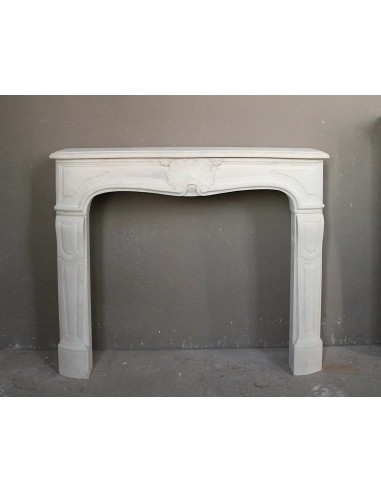In many decades of “work”*** among antique fireplaces I have never owned (nor even seen, to tell the truth) a mantel made of this incredible stone (This stone is Limestone at a high level of purity) and I believe that, before commenting on the fireplace itself, it is necessary to talk about the stone from which it was carved and to make the reader understand what is the extraordinary difference between this and its other stone sister stones.
IN PRIMIS its exceptional whiteness, at first glance unnatural so much so that its color is homogeneous in every area, without clasts (“clasts” is a “professional” word with which you always make a good impression), a word that after all means nothing more than “intruders,” that is, without stones or fossils foreign to the “paste” of our limestone. It is also important to clarify what Limestone is composed of: Of Calcium and Magnesium, both very white materials, Magnesium, even, has a white scientifically defined as “silvery,” more commonly referred to as “shining.”
THEN, its surface, which makes you want to caress it so much it is “smooth”, compact, at first appearance even “solid”.Compared to the stone that we normally happen to lift, this Blanche de Bourgogne has a much greater specific weight, very close to the weight of marble, which means that this stone is much less porous (and therefore more robust) than other stones known to us;
FINALLY, its particular stylism. The architectural layout of this mantel is, clearly as generically, definable as Louis XV,though. However, its frontal does not have the classic pair of breasts (just go to the Louis XV section to see which “breasts” I am referring to) but a frontal with a slight, very elegant and unique “fall” in the center and an overhang-also in the center-to the front)... However...the differences are not over. Now let's go and look at the legs of this elegant fireplace and it will be easy for us to notice immediately how, while in the Louis XV fireplace the legs are placed at 45° and therefore visible even from the side, our legs (very similar in workmanship to the classic Louis xv), are positioned with the gaze in front, like two little soldiers in a garret..
A Saint-Jacques shell (also a limestone shell with a very interesting history, which I will tell you about if you are interested) and a pair of wildflower corollas complete, decorating it, this pretty, nice and very original mantel.
YOU MAY OR MAY NOT LIKE THIS VERY RARE “TRANSITION” MODEL BETWEEN THE TWO STYLES LOUIS XIV AND LOUIS XIV, BUT YOU CAN'T SAY IT DOESN'T HAVE ITS OWN, VERY REFINED LINE.
CÔTE D'AZUR, BELLE EPOQUE PERIOD (LATE 19TH-EARLY 20TH CENTURY) EXCELLENT CONSERVATION.
*** I never thought of my business as a “job”, but rather an endless enjoyment.




































































